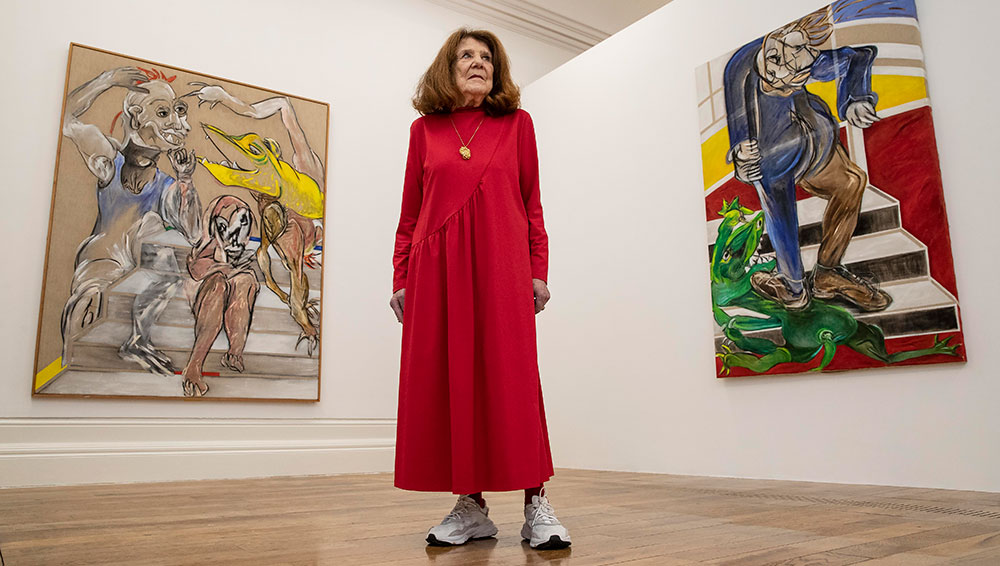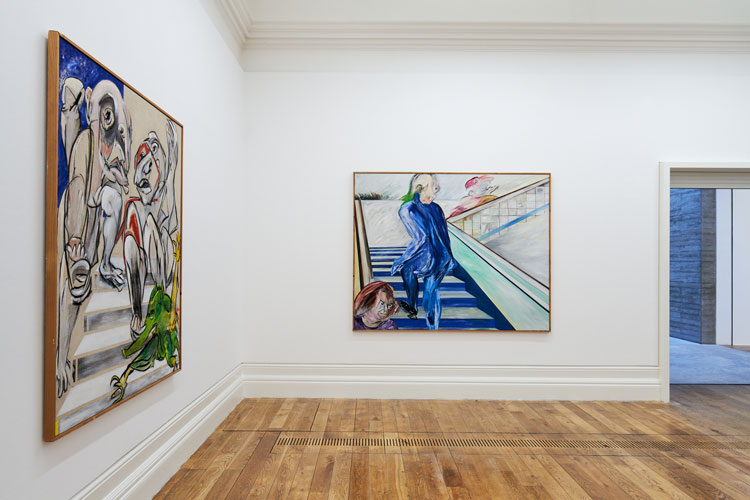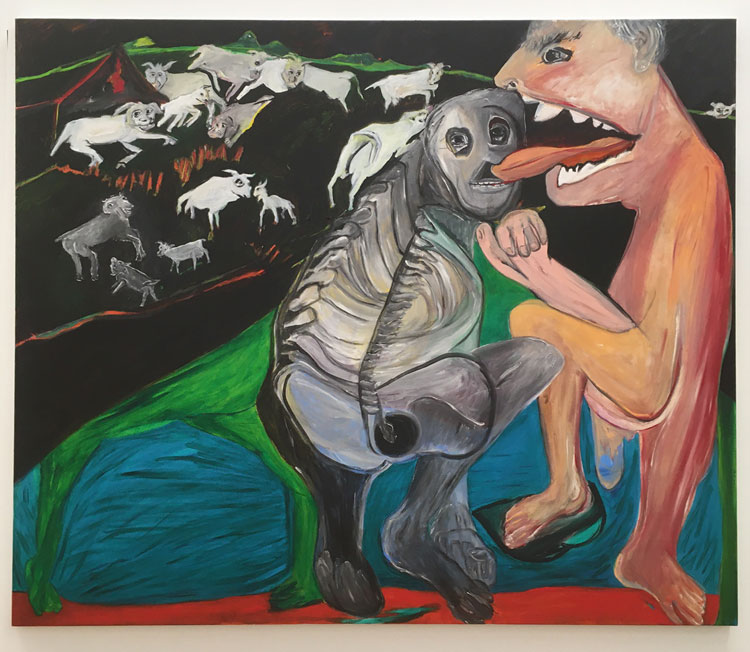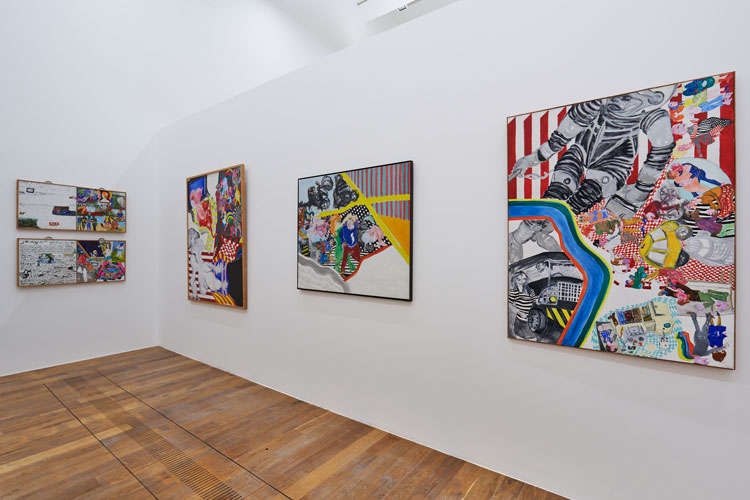
Jacqueline de Jong at Mostyn Gallery, Llandudno.
by VERONICA SIMPSON
The airy galleries of Mostyn in Wales currently pulsate with the energy and vibrant palette of Jacqueline de Jong (b1939, the Netherlands). From the prints displayed in the first gallery to the large oils in the last, she exhibits a fascination for the grotesque and the macabre, especially in the more figurative pieces representing creatures who are part human, part beast. They seem to reveal the ugly or animal side of human nature, the side we usually like to keep hidden – and yet there is beauty and seduction in these explosive colours, the dynamic compositions and expressively distorted figures.

Jacqueline de Jong: The Ultimate Kiss, installation view, Mostyn Gallery. Photo © Rob Battersby.
For all that de Jong has long had a fanbase of collectors in mainland Europe and is represented in the collections of Europe’s leading institutions, this 82-year-old artist has been under the radar in the UK, with this her first major institutional solo show here after six decades of continuous and prolific practice. Certainly, the spirit of the 60s avant garde in which she cut her teeth as an artist and activist now feels more relevant than ever. The anger and confessional intensity, plus her early and continuing experimentation with forms and materials that would place her outside the more conservative fine art canon, speak of the decade she spent living between Amsterdam and Paris, as part of the Situationist International (SI) coterie, railing against the conservatism of academia and authority of all kinds. She edited and published the Situationist Times from 1962 to 1967. For that reason and for her provocative, candid and consistent “female gaze” perspective, she is now widely recognised as one of the crucial artistic figures from the postwar years.

Jacqueline de Jong in her studio at Cité Prost, 1968.
During her six decades of experimentation, De Jong has moved between styles, formats and materials while staying true to her own uninhibited and playful spirit, as well as her distinctive, vibrant palette and fluid, restless figuration. In the excellent monograph that accompanies this exhibition, there is reference to the initial inspiration for her style coming from an early association with the Danish artist Asger Jorn, whom she first encountered as a friend of her parents (after the war, her parents were enthusiastic supporters of the art rebels of the day, including those in Jorn’s CoBrA movement) and then later as a romantic partner and political ally in the SI experiment. But she has made it very much her own, launching from this point into a multitude of aesthetic experimentations.

Jacqueline de Jong in front of Cité Prost, 1968.
A desire to engage with issues of war and violence may stem from the time and place into which she was born. At the start of the second world war, as part of a Dutch Jewish family, she and her mother were forced to flee Holland, spending time in Switzerland as refugees, while her father remained behind in hiding. They rejoined him in 1947, when she was about eight years old – certainly old enough to understand the fundamental emotions of the refugee experience. This is evidenced by the empathy in a series of paintings she produced in response to the Gulf war in 1991, and revisited before and during autumn 2020, when she completed Border Line, a series of paintings inspired by news coverage of Syrian refugees in the Mediterranean and refugees fleeing political and economic turmoil in Venezuela. These are not present at Mostyn, as they are about to go on show in New York.
De Jong’s playful experimentations also embrace the banal, as shown in her popular series of body ornaments inspired by potatoes, which she allows to shrivel, sprout and transform, before dipping them into silver and gold and turning them into jewellery. She calls these Pommes de Jong. Sadly, none of these is on show here either.

Jacqueline de Jong. The Ultimate Kiss, 2002-12. Oil on canvas, 165 x 195 cm. Photo: Veronica Simpson.
The exhibition has been jointly curated by Devrim Bayer, curator at Wiels in Brussels, Juliette Desorgues, curator of visual arts at Mostyn, and Xander Karskens, director of De Ateliers in Amsterdam. They have assembled about 80 works, across six galleries, including many of her early print and engraving works, and political posters from her time as an activist during the 1968 student protests in Paris, alongside several of her Situationist Times publications. Also on show are works from the Accidental and Suicidal paintings, plus the witty and pop-art-influenced Private Lives of the Cosmonauts, her Billiard and Série Noir paintings of the 1980s and some arresting works from the last two decades, including the show’s titular The Ultimate Kiss of 2012, whose title, she assures me, contains no hint of this show being any kind of grand finale.
In the accompanying monograph, her work is said to exemplify “dérive” (“drift”), a term coined by the SI to mean “a form of artistic meandering within a continuous process of reinvention”. She is represented in the UK by Pippy Houldsworth Gallery.
She spoke to Studio International on Zoom from her Amsterdam studio.
Veronica Simpson: Looking at the six decades of work shown here, it seems there has always been this passion for showing the failings of society, for depicting human cruelty and violence, as well as celebrations of desire and humour. That spirit of activism has not diminished after 60 years of making art?
Jacqueline de Jong: No, (laughs) should it? I am still the same person. Perhaps I grew up a little in the meantime. But, no, my empathy with the world and what is happening in the world is still going on and I’m expressing it. My style has been changing a lot, but not that.

Jacqueline de Jong: The Ultimate Kiss, installation view, Mostyn Gallery. Photo © Rob Battersby.
VS: Curiosity and an appetite for experimentation seem to me to be essential for an artist, but market forces – the commodification of art and artists – can work against that. It seems you have always resisted that commodification and categorisation.
JDeJ: Obviously, I’ve never been affected by this and never really had the chance of being affected by this. But, on the other hand, it is a risk for very young artists when they have a success and a demand that they get into the trap. But if you are a little bit intelligent, you don’t get into that trap.
VS: What do you think of the pressure on artists to develop signature gestures or subjects that they repeat in endless variations, but without the spirit of that investigative curiosity with which they started? They then seem to me to become a “brand” that galleries and auctioneers know can be marketed ever-more successfully. For example, I feel I know exactly what to expect with a David Hockney show.
JdJ: I disagree. I think he is exactly an example of someone who does change.
VS: The iPad drawings?
JdJ: Yes. I think it’s quite amazing. No, no, I think he has been changing. He has his signature, but if you look at my work you can see the signature even if the style is different and the subjects are different. If you see Alice Neel, for example, it’s always the same. That I don’t agree with. There I think you are very right to say that when you get into a show, you know what it will be about.
I don’t find that approach inspiring. You could take the example of Francis Bacon, who really worked in all the ways he wanted to, and he was selling, and he had his contract with Marlborough and he was being paid monthly for making his work, but he was completely free and did what he wanted to. It doesn’t have to mean that a certain sort of work sells, and you have to go on doing that work.
-oil-on-canvas-200-x--160cm--from-the-Upstairs-Downstairs-series.jpg)
Jacqueline de Jong. Big foot, small head, 1985. Oil on canvas, 200 x 160 cm. Photo: Veronica Simpson.
VS: But for Bacon they were different times – there was hardly any market for contemporary art. There would not be the pressure to produce more of the same, a pressure to which you have clearly not succumbed.
JdJ: I didn’t have to compromise, obviously not. I never compromise, no way. I could never do it. Not even today. In a way, most of the artists don’t compromise.

Fourth conference of the Situationist International, British Sailors’ Society, London, 1960.
VS: I was very interested when I found out about your work as an editor, a publisher, for the Situationist Times. As someone who has edited magazines, I can relate to that desire to tell a story by the careful assembling of inspirational examples, curating a specific visual and verbal landscape to educate people, to set out a manifesto. Did you enjoy your time as an editor of the Situationist Times?
JdJ: I enjoyed it very much for as long as it lasted. I called myself an editor and a publisher to be freer than I would be as either an editor or a publisher. But there was no restriction between one or the other.
VS: With printed magazines, there is – or was - a feeling that you can present a whole universe that people would be immersed in and spend time with. We have moved to very different times where people want to consume and sample culture in an instant, through Instagram or in soundbites on their phones. On the other hand, they can access information on any artist they like from amazing websites and journals online. What are your thoughts on this evolution of the media?
JdJ: Since the arrival of the internet, everything has changed and I can’t say I regret it. Freedom is much larger, possibilities are huge and the situation is so completely complementary to the “only printed media” situation in which I made my magazine. I mean, it is pretty long ago – 60 years of change makes a lot of change. I don’t regret it at all. I mean, the whole magazine I made, the Situationist Times, is online. And that’s one of the things I wanted. Yale (University Press, which holds her archive) bought the magazine: it owns it now, but the rights are mine and one of the reasons it’s online is because it’s not copyrighted.
.jpg)
Jacqueline de Jong. Peeing Hamlet, 2012. Oil on canvas, 160 x 100 cm. Photo: Veronica Simpson.
VS: Can we talk about the sense of theatricality and banality in the work? For example, I love the tension in the Billiards paintings – there are cinematic slices of action taken from unusual, dynamic angles, or sometimes a temporary suspension of the game, with extraordinary attention paid to the green of the billiards table, the contours, texture, colours and materials of the cue, the balls.
JdJ: I wanted to become an actress when I was 18 years old, and I had a chance to study for three months at the Guildhall and also in Paris, but I stopped because it didn’t work out. I failed. But that doesn’t mean I didn’t learn anything.
.jpg)
Jacqueline de Jong. Le Jour des Montagnes Philosophiques, 1984. Oil on canvas. 200 x 300 cm. Photo: Veronica Simpson.
VS: A painting I particularly loved was Le Jour des Montagnes Philosophiques (1984), which is so full of fluidity and movement.
JdJ: Well, that is an occasional painting I made during a fashion show. I made it on stage while the fashion show was going on around me. Well, I didn’t make it, I started it and finished it in the studio later on. But the movement in it comes from the fashion show, definitely.
VS: What is the significance of the painting whose title gives the show its name: The Ultimate Kiss.
JdJ: It’s a painting which I made in France and then I took that painting and another one (also in the show) which is called Drowned, at the same moment and I repainted them in 2012. It had to do with the fact that my husband passed away in 2009. And they are sort of mourning paintings.
.jpg)
Jacqueline de Jong. Upstairs-Downstairs, 1986-88. Oil on canvas, 200 x 165 cm. Photo: Veronica Simpson.
VS: They are very moving, powerful. I also enjoyed the series of Upstairs Downstairs paintings, which were commissioned for Amsterdam town hall. I love the idea of the politicians looking at these pictures, which show many of your half-human, half-beast figures, as they go up and down the staircase. Was that part of your thinking – to reflect the duplicitous aspect of government?
JDJ: Well, it was a more practical commission. Four hundred people tried to get this commission and 16 were chosen. Of them, five were chosen for the parts where there were stairs and elevators. It is as practical as that. That’s why I called it Upstairs Downstairs. I made 25 paintings. But it’s a town hall, it’s not only politicians working there. There are lots of civil servants, too, and civilians.
VS: Reading about the Border Line series in the monograph for this show, I would love to see these works. Can you tell me a little about them?
JdJ: Well, go to New York in November and you will see them. It would be a very good idea. They are about refugees mainly, Syrian not from Afghanistan, because I made work about that not so long ago. Also, there are South American refuges. What I used are mainly newspaper and television images and I just made a story out of them – not my story, but their story via me.
• Jacqueline de Jong: The Ultimate Kiss is at the Mostyn Gallery, Llandudno, North Wales, until 6 February 2022. The exhibition will travel to the Kunstmuseum Ravensburg, Germany, from 12 March to 19 June 2022.